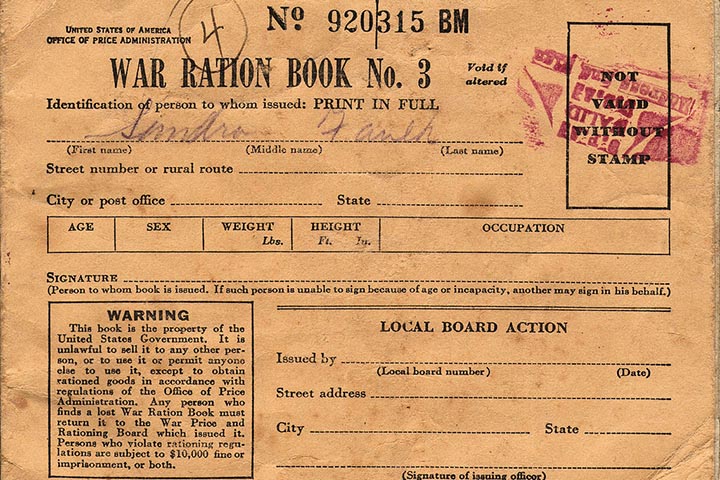When envisioning vintage, one often thinks of the 1970s hip-huggers or the bobs of the 1950s, but rarely does one think of World War II (WWII) and food rationing when considering “vintage” trends. WWII was a dark time that most attempt not to recall; however, the diets and recipes of those times are not forgotten. Human history is marked by war and the quirky trends it creates. There is a wealth of information on this period and the living conditions amongst the Allied and Axis forces that could cover many volumes. We would like to highlight the conditions primarily in Britain and the United States.
How Was Food Rationed in World War Two?
Rationing was developed during the war to ensure that all citizens had enough to eat and to prevent bread line riots. Americans and Europeans alike were affected by rationing and came up with creative ways to make the most of what they were allotted. Many notable American and British women’s magazines joined in the effort with recipes and adverts promoting ways to stretch food.
Ironically, even the very paper they were printed on was rationed, and they therefore had to encourage sharing of their pages with neighbours. Victory gardens, also known as war gardens were created as a way to ease pressure on the food supply and enable governments to send more food to the warfront.
“By 1943, 40% of all produce eaten by Americans was grown in over 20 million victory gardens (wartime US population was much lower than today),” says Lauren Handley Eckert, Education Programmes Coordinator at The National WWII Museum in New Orleans. These gardens helped to provide enough fruits and vegetables for people on the home front and allow a large portion to be sent to the troops abroad.
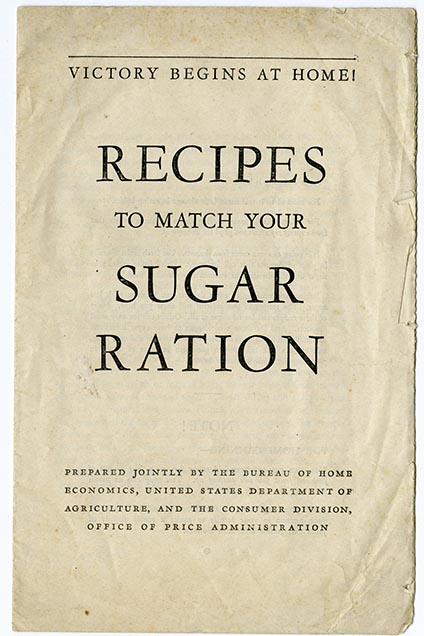
What Foods Were Rationed in World War Two?
“The first foods rationed in Britain were bacon, sugar, tea, butter, eggs and meat. There were no bananas and many children did not learn of them until the war. In the US butter, eggs, spices, bourbon, meat, sugar, cooking oil, coffee, canned goods were tough or impossible to get,” according to Cynthia Bertelsen, writer, historian, and photographer. This meant no banana splits and no ice cream sundaes; many of the treats relished by children were put aside during the war. SPAM, a tinned meat, created for soldiers’ rations, is a recognisable holdover from that dark time. Meat, oils and butter were all rationed in most countries that took part in the war.
A typical weekly British ration contained bacon and ham 4oz, other meat to the value of 1s 2d, butter 2 oz, cheese 2 oz, margarine 4 oz, cooking fat 4oz, milk 3 pints and 1 packet dried skimmed milk per month, sugar 8oz, preserves 1lb every 2 month, tea 2oz, 1 shell egg and 1 packet dried egg per month and sweets 12oz.
Non-rationed items like potatoes and carrots were used as filler and mock foods and casseroles were popular ways to make food go further. Britain even had “Doctor Carrot” carrying a bag of “VitA” that became a propaganda item touted by the Ministry of Food. There were several slogans that accompanied “Doctor Carrot,” but he was used to encourage the use of carrots as a healthy source of vitamin A. Carrots were often used in desserts as sweeteners and were substitutes for vegetables that could not be obtained. “Potato Pete” was also introduced in Britain to inspire people to use potatoes as a substitute for unavailable commodities.
This is not to say that the world was a completely dark and dismal place. Birthday cakes did not disappear in the US. “As for treats, there were still birthday cakes and wedding cakes and such. Home sugar rationing meant that you might save up your points and/or sugar or the whole neighbourhood might get together to contribute ingredients for a special occasion. You could also buy things from commercial bakeries, which got more sugar than your average housewife/family,” says Handley Eckert.
However, the picture was not as rosy for Europeans. In Britain an account by Anne Addison and published by Fulwell Writers’ Circle tells: “Sweets were devised from a mixture of dried milk and peppermint essence with a little sugar or icing sugar if available. Grated carrots replaced fruit in a Christmas or birthday cake, while a substitute almond paste was made from ground rice or semolina mixed with a little icing sugar and almond essence. Dried egg powder was used as a raising agent, and this same dried egg could be reconstituted and fried, yielding a dull, yellow, rubbery-like apology for the light and fluffy real thing – but there was nothing else, so we ate it.” People made do and used what they had to keep uplifting events like birthdays and weddings as cheerful as possible.
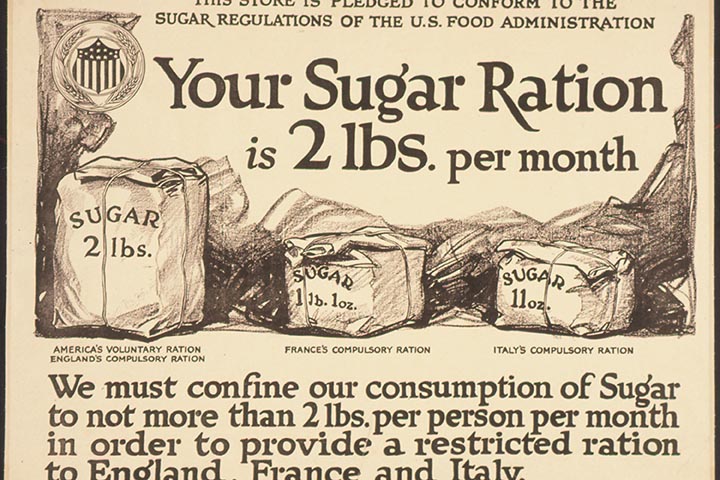
Why Was Oil Rationed in World War Two?
This world was in stark contrast to the present day. Women saved and reused oil and then brought the waste oil to the butcher who paid for it. In turn, the butcher would sell it to a rendering plant that would turn it into explosives. The war was a time of stretching and making do. Everyone was expected to do their part.
The motto, “so they will have enough” developed, meaning that all the hardship the common citizen went through was to ensure the troops had everything they needed. Recycling and reusing were mandated in all aspects of daily life. The items that most households throw out today would be held onto, knowing that each had to do their share. Being a glutton at this time was not just looked down upon, it was downright treasonous. Rations varied from country to country but one thing was certain, citizens of all countries were encouraged to grow their own food so that soldiers could be supplied with whatever could be spared.
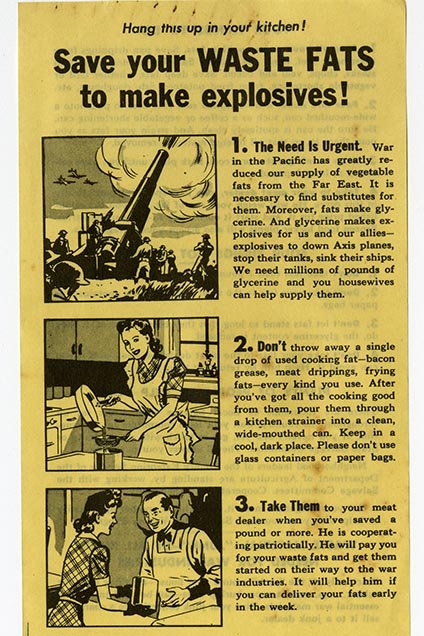
What Happened to Restaurants in World War Two?
Interestingly, restaurants in Britain were not subject to rationing. Bertelsen says: “Exclusive restaurants in Britain could not charge more than a certain amount, 5 shillings per meal, after 1942; prior to that only the wealthy cold afford to eat there. Restaurants in Britain were ‘off ration’ and so people ate out when they could.” By contrast, American citizens were encouraged to eat at home rather than in a restaurant.
Handly Eckert explains: “Restaurants used what they could find, and did have rationed limits on how much they could get of rationed items, and would alter their menu according to what was available, but again, true food shortages were never a huge issue in the US during WWII. Though not technically rationing, the OPA (Office of Price Administration) did have ceiling prices for dishes at restaurants. They legally could not charge more than a set amount for menu items.” This means that trip to the local burger joint would be out of reach for most in any of the countries involved in the war.
This look at rationing envisions a different view of vintage, one that is not always happy or fun. This vintage is the foundation our modern world has been built upon, and one that should not be quickly forgotten. It was a time of citizens banding together and each doing their part. Rationing has left us a legacy of recipes, food products and strength in the face of adversity. Think vintage, think differently!
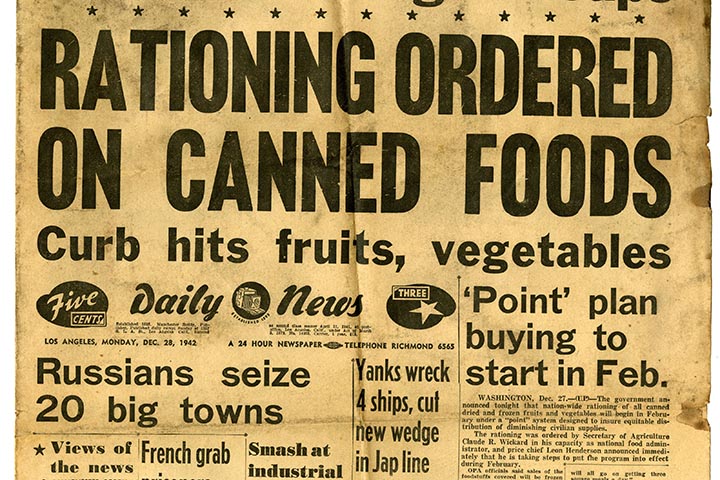
For more information we suggest you to visit the blog Gherkins Tomatoes by Cynthia Bertelsen covering mostly French rationing and the book: How to Cook a Wolf by M. F. K. Fisher.
